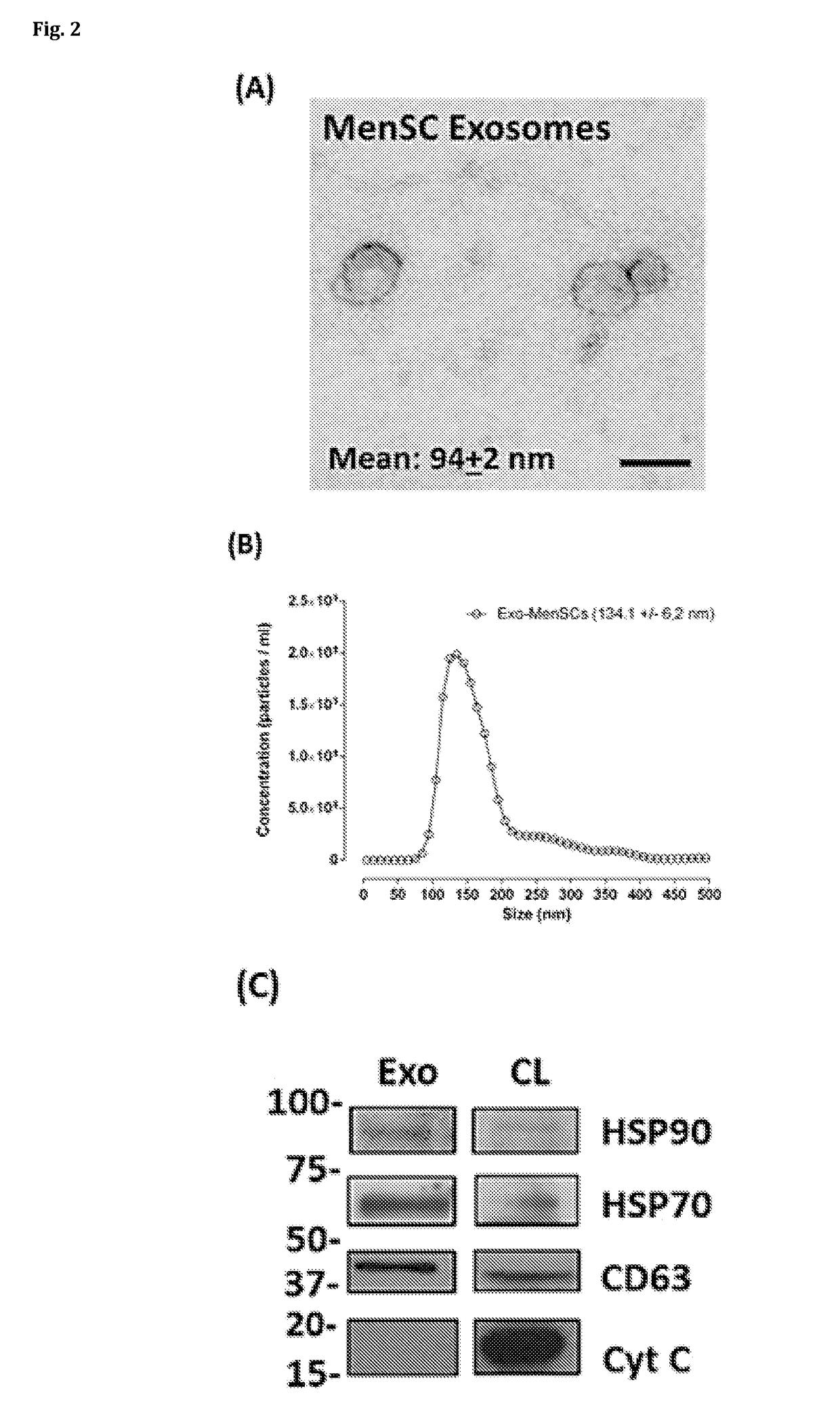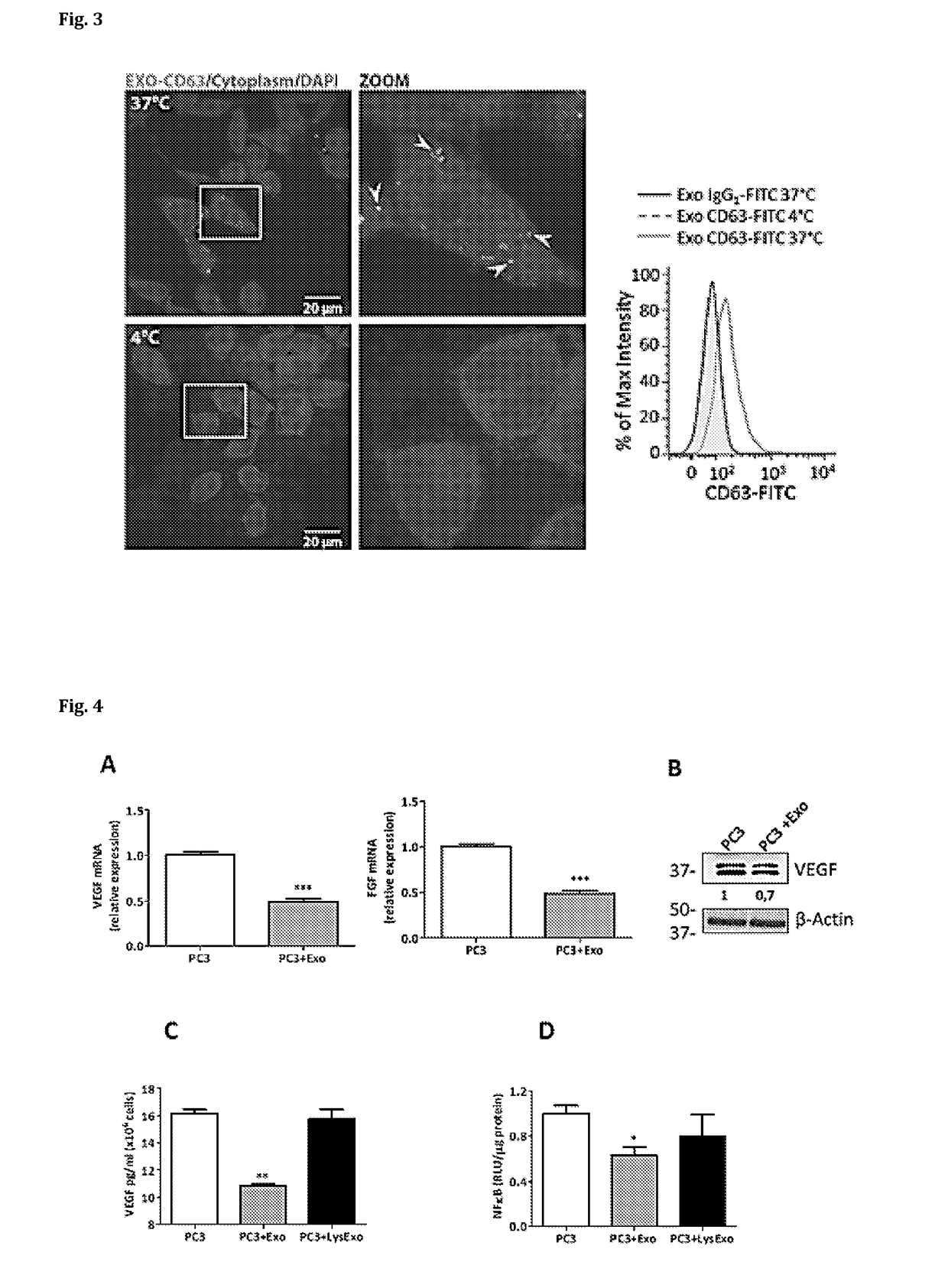Anti-angiogenic therapy based on exosomes derived from menstrual stem cells
a technology of exosomes and stem cells, applied in the field of new medical treatments, can solve the problems of limited success of anti-angiogenic drugs
- Summary
- Abstract
- Description
- Claims
- Application Information
AI Technical Summary
Benefits of technology
Problems solved by technology
Method used
Image
Examples
example 1
Characterization of MEnSCs and MenSCs-Derived Exosomes
[0103]Consistently with previous reports (“Characterization of menstrual stem cells: angiogenic effect, migration, hematopoietic stem cell support in comparison with bone marrow mesenchymal stem cells”. Alcayaga-Miranda F et al., Stem cell research & therapy. 2015; “The immunosuppressive signature of menstrual blood mesenchymal stem cells entails opposite effects on experimental arthritis and graft versus host diseases”. Luz-Crawford P et al., Stem cells. 2016; “Combination therapy of menstrual derived mesenchymal stem cells and antibiotics ameliorates survival in sepsis”. Alcayaga-Miranda F et al., Stem cell research & therapy. 2015; “Endometrial regenerative cells: a novel stem cell Population”. Meng X et al., Journal of translational medicine. 2007), MenSCs express CD105, CD44, CD73, CD90 and HLAABC, but showed negative expression for CD45, CD34, CD14 and HLA-DR (FIG. 1A). Also, mesodermal lineage induction showed positive spe...
example 2
Exosomes Uptake by Tumor Cells
[0105]The uptake of exosomes by PC3 cells was studied using FACS and confocal microscopy. As shown in FIG. 3 (left panel), anti-CD63-FITC labeled exosomes were localized in the cytoplasm of PC3 cells revealing the internalization of the exosomes. Consistently with other reports (“Interaction and uptake of exosomes by ovarian cancer cells”. Escrevente C. et al., BMC cancer. 2011; “Exosome uptake depends on ERK1 / 2-heat shock protein 27 signaling and lipid Raft-mediated endocytosis negatively regulated by caveolin-1”. Svensson K J et al., The Journal of biological chemistry. 2013), no green fluorescence signal was detected after incubation at 4° C., indicating that exosomes internalization by PC3 cells was mediated by an energy-dependent process. The quantification of these data showed that PC3 cells contain 28.25±2.85% of green fluorescent exosomes based on the percentage of max intensity of the population peaks after 3 hours of incubation; meanwhile a de...
example 3
Antiangiogenic Capacity of MEnSCs Exosomes in Prostate Cancer In Vitro
[0106]As shown in FIG. 4A, MenSCs-derived exosomes down-regulated the mRNA levels of VEGF and bFGF in PC3 cells (p<0.001). This was further confirmed by the reduction of the protein level of VEGF in comparison with untreated cells (FIG. 4B). To confirm the antiangiogenic effect of exosomes, secreted levels of VEGF were determined in the PC3-CM. The lysed exosomes condition was used as control to confirm the exosomes specific effect. Consistently with the downregulation of the VEGF mRNA levels, a ˜1.5 fold (p<0.01) decrease in VEGF secretion was detected in the PC3-CM treated with MenSCs-derived exosomes. In contrast, the lysed exosomes condition had no effect on the secretion of VEGF, corroborating an exosomes-specific response (FIG. 4C).
[0107]As shown in FIG. 4D, exosomes treatment decreased the NF-κB activity compared with untreated PC3 cells (p<0.05), while the addition of lysed exosomes had no effect in NF-κB ...
PUM
| Property | Measurement | Unit |
|---|---|---|
| volume | aaaaa | aaaaa |
| diameters | aaaaa | aaaaa |
| diameter | aaaaa | aaaaa |
Abstract
Description
Claims
Application Information
 Login to view more
Login to view more - R&D Engineer
- R&D Manager
- IP Professional
- Industry Leading Data Capabilities
- Powerful AI technology
- Patent DNA Extraction
Browse by: Latest US Patents, China's latest patents, Technical Efficacy Thesaurus, Application Domain, Technology Topic.
© 2024 PatSnap. All rights reserved.Legal|Privacy policy|Modern Slavery Act Transparency Statement|Sitemap



